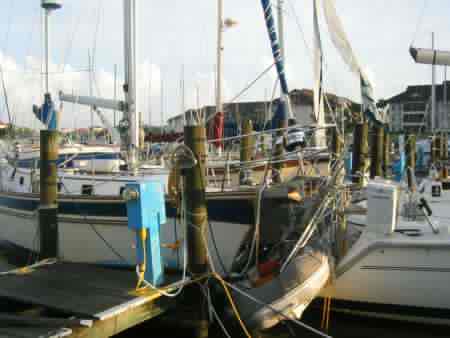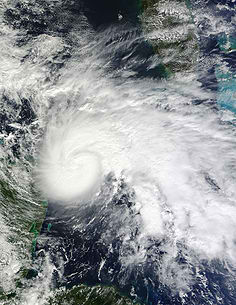
1. Reduce Windage!
Imagine the force of 140 mph winds, gusting to who knows what. They’re capable of tearing off roofs, flattening buildings and breaking masts. Now look at your boat. Anything that could add windage in a hurricane needs to be removed and stored below. The obvious items are the bimini, dodger, a cockpit enclosure, anything like a mack pack or stack pack canvas.
Once you’ve removed all the canvas, stand on deck and look around envisioning wind so forceful that you can’t stand against it and decide what else needs to be stored below. For us, it’s things like the lifering/horseshoe, the man overboard sling, the portable generator. Some boaters even go so far as to store their outboard below decks! We leave our outboard on the rail but we do store the empty gas can below decks. We hide our jerry cans (empty, of course) in the lazarette, the removable boarding ladder goes into the quarterberth, anything that we see when we look around that might provide resistance to hurricane winds goes below. Even the KISS wind generator blades are removed and stored below. We don’t have cockpit cushions, but we do have cockpit beanbags and those go below along with the rug that normally lives at the step outside the companionway.
Aboard Winterlude, we go to extremes to remove windage … we carry 2 kayaks on the lifelines on each side. When we’re anchored, we remove the kayaks and lash them to the decks. This year since we’re back in SW FL for a mini-refit, we’re taking the kayaks back home — during Charley we had a caretaker that was able to store the kayaks ashore during the hurricane. This year, we don’t have any place to store the kayaks ashore in the event of a hurricane, so we’ll take them home. And who knows, maybe they’ll venture with us to Maine this summer since we now have the kayak roof racks! 🙂
The dinghy is deflated and lashed to the foredeck so as to provide as little windage as possible.
2. Close all Seacocks!
We always close almost all of our seacocks. The sink seacock stays open since the dehumidifier drains into the sink, but it’s above the waterline. Also we leave the cockpit drains/scuppers so that any torrential rains can drain out of the cockpit. The cockpit drains are also above the waterline.
Next Hurricane Preparedness #3 …. stay tuned!












Added, I enjoy your site! 🙂
Thx! You are CC’s 1st comment! Thx Georgina – hopefully as the weeks go on, we’ll have more content that’s useful & people enjoy! Cheers! J